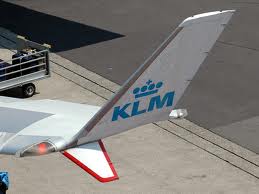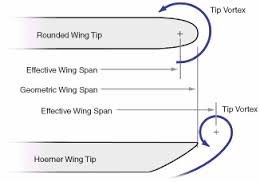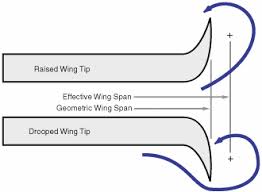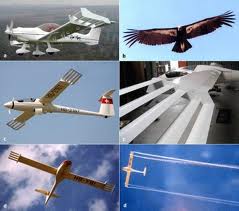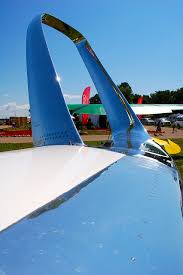Aircraft wing tip shape
As I have introduced in last post about winglet (an wing tip device) . how it improves the aircraft stall characteristics , and also increases the effective span and effective aspect ratio of the wing.
SOME MORE POINT ABOUT WINGLET
The winglet is cambered and twisted so that the rotating vortex flow at the tip creat a lift force on the winglet that has forward component. This forward component act as a negative drag, reducing the total wng drag.
A properly designed winglet can potentially provide an effective span increase up to double that bought by adding the winglets height to the wing span.
Winglets provide the greatest benefit when the wing tip vortex is strong, so a low aspect ratio wing will see more advantages fram the use of winglet than an already highly efficient high aspect ratio wing.
Now here , I am going to discuss about the type of wing tip shape that affect the aerodynamics of aircraft and its advantages and disadvantages.
TYPES OF WING TIP DEVICES
- End plates
- Classic Winglet (Whitcomb)
- Blended Winglet
- Hoerner Tips
- Upswept and Drooped Tips
- Wing Grid
- Sail Tips
- Spiroid Tips
- Tip Turbines
1) END PLATES
- End plates are most common and most effective type.
- It work same as like T –tail.
- Above fig shows how it affects the span and aspect ratio of wing.
2) CLASSIC WINGLET (WHITCOMB
- It Defined by Whitcomb
- The Upper winglet begins at the point of maximum thickness of wing airfoil.
- It having a sweep same as In wing.
- The Span of it(upper part) equals to the tip chord of the wing.
- Its camber is generally higher than wing.
- Lower winglet contributes little to drag hence it often omitted.
3) BLENDED WINGLET
- Greatly reduces the adverse flow conditions at winglet junction.
- The Blended Winglet incorporates a large radius and a smooth chord variation in the wing-to-winglet transition area. This allows optimum aerodynamic loading and avoids vortex concentrations that produce drag.
- High AR blended winglet can be up to 60% more effective than a conventional winglet.
- Most important parameter in design is the ratio of winglet high to wing span.
- Blended Winglets enhance longitudinal and directional stability, thereby providing better handling in turbulent atmospheric conditions.
4) HOERNER TIP
- this is a sharp edged wing tip with the upper surface continuing the upper surface of the wing.
- The lower surface is “undercut” and canted approximately 30 deg to the horizontal. It may also be undercambered (concave).
- It is somewhat similar to conventional tip.
5) UPSWEPT AND DROOPERD TIP
- Similar to Hoerner Tips but curve either up or down to increase the wing’s effective span.
- This effect is similar to that employed by endplates.
6) WING GRIDS
- The circulation is taken over by the wing grid along the chord of thE main wing.
- The segmented circulation is transferred to the end of the wing grid, increasing the far field vortex spacing.
- The lift distribution on several winglets results in a reduction of the far field vortex energy.
- Induced drag is reduced by the wing grid up to 60%, that corresponds to span efficiencies of up to over 3.0, that means that total drag can be reduced up to 50% depending on velocity and design.
- The winggrid has two distinct operating regimes:
1) Below a critical angle of attack (above a specific design speed) span efficiency is between 2.0 and 3.0 with full wing grid effect.
2) Above a critical angle of attack (below a specific design speed) the effect of reduced induced drag fades out, the winggrid perates as a slit wing with very high stall resistance.
7) SAIL TIP
- Sail tip is defined by multiple high Aspect Ratio lifting elements at several dihedral angles.
- This kind are more complex to design and analyze .
8) SPIROID WING TIP
- Spiroid wing tip produces a reduction in induced drag, much like that of a winglet. However, its closed planform shape may make it possible to reduce local lift coefficient often a problem for winglets.
- Extensive optimization is necessary.
- The major concern with it is fluttering of tip.
- It reduce fuel consumption by 6-10% as compared to conventional tip.
9) TIP TURBINE
- Reduce the strength of vortices.
- Recover energy required to overcome the drag.
- It is estimated that a similar system on B747 would result in the recovery of 400hp(source).



